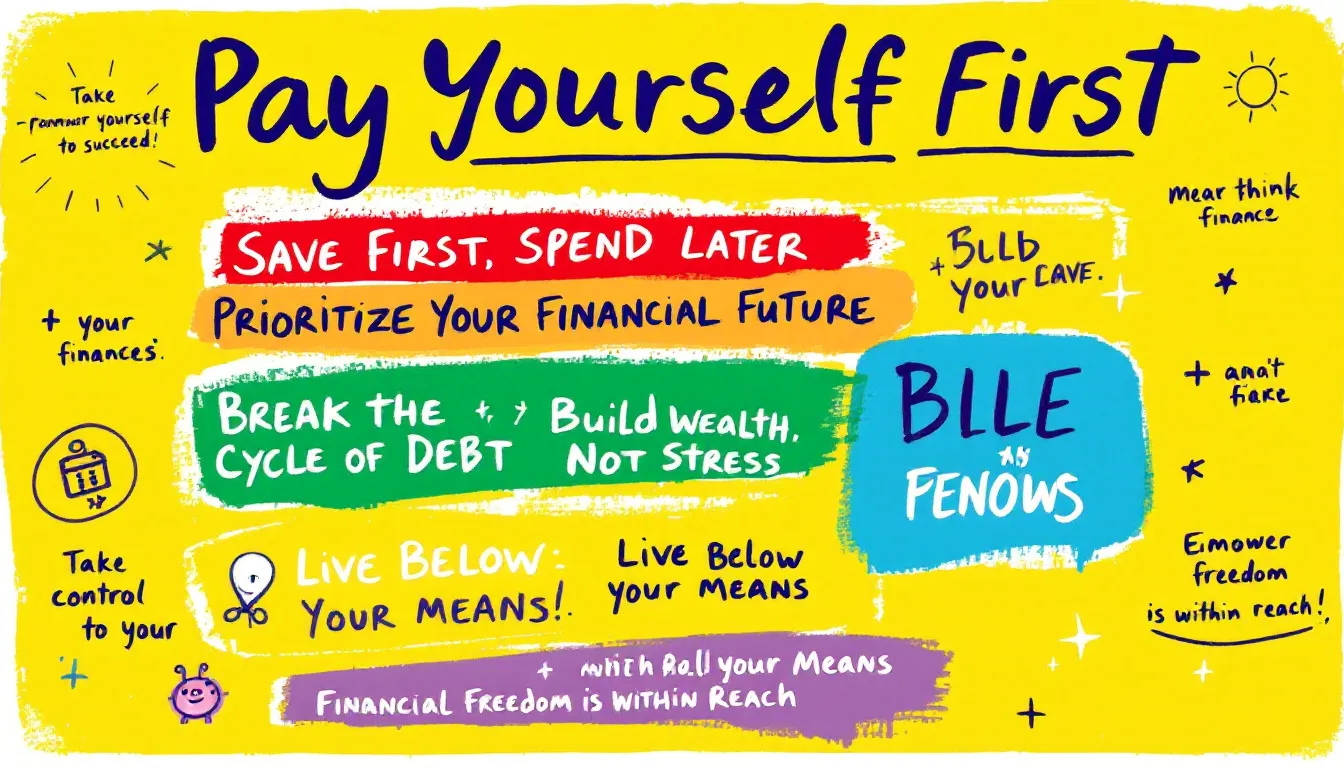Pay Yourself First: Mastering Smart Budgeting for Financial Success
Pay yourself first means prioritizing your savings by setting aside a portion of your income before paying any other expenses. This simple method helps you consistently build savings, ensuring your financial goals are met over time. In this article, you’ll learn what ‘pay yourself first’ entails, its benefits, and how to implement it effectively into your budgeting routine.
Pay Yourself First
Key Takeaways
-
The ‘Pay Yourself First’ method prioritizes saving a portion of income before addressing expenses, fostering a consistent savings habit.
-
Automating savings through transfers simplifies budgeting and supports achieving both short-term and long-term financial goals.
-
Balancing savings with debt repayment is crucial for financial health, emphasizing the importance of prioritizing high-interest debt while building savings.
What Does "Pay Yourself First" Mean?
At its core, the pay yourself first budgeting method is a strategy that encourages you to save money before you spend on any other expenses. This approach is often termed ‘reverse budgeting’ because it prioritizes savings over all other financial obligations, effectively turning the traditional budgeting process on its head. The main goal here is to grow your savings consistently, ensuring that your future financial needs are met before addressing your current expenses.
The key to success with the pay yourself first method lies in its consistency. Automatically transferring a portion of your income into a separate savings account reduces the temptation to spend impulsively and enhances financial discipline. This approach is particularly beneficial for regular paycheck recipients or business owners who make consistent withdrawals.
The ultimate result is a robust savings habit that strengthens your financial security.
Benefits of the Pay Yourself First Method
One of the most significant benefits of the pay yourself first method is its ability to help you achieve both short-term and long-term financial goals. Prioritizing savings helps you steadily work towards important objectives such as building an emergency fund, planning for retirement, or saving for a major purchase. This method supports consistent savings, allowing you to avoid the stress of last-minute scrambles for funds when unexpected expenses arise.
Another advantage of this budgeting technique is its simplicity and low maintenance. Once you automate your savings deposits, you no longer need to manually transfer money each month, making it a straightforward and less time-consuming way to save. This ease of use is particularly appealing for individuals who prefer a hands-off approach to managing their finances.
Moreover, the pay yourself first method helps you build financial security by reducing impulsive purchases and encouraging disciplined spending habits. Setting aside a percentage of your income—typically around 10% to 20%—simplifies the saving process and ensures consistent progress towards your financial goals. Ultimately, this approach fosters a healthier financial lifestyle, enabling you to meet your savings goals with minimal effort.
How to Start Paying Yourself First
Starting with the pay yourself first method involves a few crucial steps. First, you need to calculate your monthly income to understand how much you can realistically save. Next, set up automatic transfers to ensure that your savings are prioritized without requiring manual intervention.
Finally, allocate your savings to specific goals, such as an emergency fund or retirement, to enhance your financial health and security.
Calculate Your Monthly Income
Effectively starting the pay yourself first method begins with determining your monthly income. This involves calculating your take-home pay after taxes and mandatory deductions. Understanding your net income is crucial because it gives you a clear picture of how much money you have available for saving and spending each month.
If you have irregular income, it can be slightly more challenging to determine a consistent amount to save. In such cases, consider averaging your income over several months to find a reliable figure. Knowing your monthly income allows you to set a realistic percentage for savings, ensuring you can still cover living expenses while prioritizing savings.
Set Up Automatic Transfers
Setting up automatic transfers is a cornerstone of the pay yourself first method. This step ensures that a predetermined amount of your income is automatically deposited into your savings account with each paycheck. Automating your savings reduces the need for manual intervention, making it easier to maintain consistent savings habits. Most banks offer quick and easy setups for automated deposits, allowing you to direct funds to various accounts, including savings and investment accounts.
Establishing automatic transfers also enhances your ability to build an emergency fund. This dedicated account can help you manage unexpected expenses without derailing your long-term financial goals. Automating your savings not only simplifies the process but also ensures that you consistently contribute to your financial security.
Allocate Savings to Specific Goals
Once you have automated your savings, it’s essential to allocate those funds towards specific goals. This strategy helps you stay focused and motivated, knowing that each dollar saved is working towards a particular financial objective. Common goals include building an emergency fund, saving for retirement, or setting aside money for a major purchase like a home or a vacation.
Creating separate savings accounts for each goal can further enhance this strategy. For instance, you might have one account for your emergency fund, another for retirement savings, and a third for other long-term financial goals. Diversifying your savings across multiple accounts helps you better track your progress and ensures adequate preparation for various financial needs.
Prioritizing Savings Over Other Spending
Prioritizing savings over other spending is a fundamental principle of the pay yourself first method. Establishing clear financial goals allows you to focus on what truly matters and avoid distractions from daily expenses. Tracking your cash flow can reveal opportunities to adjust your spending and increase your savings contributions.
It’s crucial to manage discretionary spending and avoid accumulating excessive credit card debt, as these can hinder your ability to save effectively. Prioritizing savings helps build an emergency fund, serving as a financial buffer for unforeseen expenses. This approach ensures that your essential expenses are covered while still working towards your long-term financial goals.
Adjusting Your Budget for Financial Emergencies
Financial emergencies can strike at any time, and adjusting your budget to accommodate these unexpected costs is essential. The pay yourself first method is particularly effective for building an emergency fund, serving as a financial buffer during challenging times. This fund should be specifically reserved for unplanned expenses that are not part of your routine budget.
Knowing what qualifies as an emergency expense is crucial to avoid misusing your emergency funds. Common examples include medical emergencies, car repairs, or sudden job loss. Managing budgeting constraints during financial emergencies may involve trimming non-essential expenses or exploring supplemental income options.
If you are living paycheck to paycheck, focus on growing your income, making lifestyle adjustments, or decreasing debt to create a more sustainable financial plan. When faced with insufficient funds to cover both needs and savings goals, it’s important to prioritize. Look for ways to reduce expenses or concentrate on one savings goal at a time. This approach ensures that you remain financially resilient even during unexpected financial challenges.
Types of Accounts for Saving Money
Choosing the right types of accounts is crucial for effectively implementing the pay yourself first method. Various accounts can be used, including savings accounts, checking accounts, and investment accounts. Savings accounts are particularly important for achieving short-term financial goals and can be specifically utilized for the pay yourself first strategy.
For long-term savings and retirement planning, consider using an investment account such as IRAs and 401(k)s, including a retirement account and retirement accounts. A checking account can also play a role by facilitating automatic transfers to savings or investment accounts, ensuring that your savings plan remains on track.
By diversifying your savings across different account types, you can optimize your financial strategy and achieve a balanced approach to saving money.
Balancing Savings and Debt Repayment
Balancing savings and debt repayment is a critical aspect of maintaining financial health. Paying off high-interest debt should take priority over additional savings contributions, as the cost of debt can outweigh potential investment earnings. Utilizing the debt avalanche strategy, which prioritizes paying off debts with higher interest rates first, can help you manage debt more effectively.
Debt consolidation is another useful tactic, simplifying payments by combining multiple debts into a single monthly obligation. Classifying debt payments as part of your overall savings strategy can assist in financial planning and ensure that you remain focused on reducing debt while building savings.
Once your debts are paid off, you can allocate more funds towards your savings goals, enhancing your financial security. Creating a budget that effectively allocates funds for both debt repayment and savings contributions is essential. By maintaining a balance between these two financial priorities, you can achieve long-term financial stability and success.
Using Budgeting Tools and Apps
Incorporating budgeting tools and apps into your financial strategy can greatly enhance your ability to manage the pay yourself first method effectively. Apps like Acorns allow users to invest spare change automatically, making it a suitable option for those who prefer a hands-off investing approach. These tools can track your spending habits and savings progress, ensuring that you adhere to your financial goals.
Embracing technology for budgeting not only simplifies the process but also enhances financial awareness. By using these tools, you can stay disciplined and focused on your savings goals, making it easier to achieve consistent savings and financial security.
Summary
The pay yourself first method is a powerful strategy for achieving financial success. By prioritizing savings and automating deposits, you can consistently work towards your financial goals with minimal effort. This approach helps you build an emergency fund, reduce impulsive spending, and maintain financial security. Embrace this method and take control of your financial future, ensuring that you are well-prepared for any challenges that come your way.
Frequently Asked Questions
What is the pay yourself first method?
The pay yourself first method is a budgeting strategy that emphasizes saving a portion of your income before allocating funds to other expenses. This approach helps ensure that you meet your savings goals consistently.
How do I start paying myself first?
Start paying yourself first by calculating your monthly income and setting up automatic transfers to a savings account dedicated to your financial goals, such as an emergency fund or retirement. This strategy ensures your savings grow consistently and prioritizes your financial well-being.
Why is it important to prioritize savings over other spending?
Prioritizing savings is essential for establishing financial security and preparing for future goals. It not only reduces impulsive spending but also helps you navigate both expected and unexpected financial challenges.
What types of accounts should I use for saving money?
To effectively save money, utilize a combination of savings accounts, checking accounts, and investment accounts. This diversified approach optimizes your financial strategy and enhances your savings potential.
How can I balance savings and debt repayment?
Balancing savings and debt repayment can be achieved by prioritizing high-interest debt first, utilizing strategies such as debt consolidation, and creating a budget that allocates resources for both debt repayment and savings. This approach ensures you reduce debt effectively while also building your savings.
Bountisphere: Your Finances, Secure and in Your Control
We prioritize your safety by using the most advanced security technology to protect your personal data. With Bountisphere, your information is completely secure — we’re read-only, so no changes can be made to your accounts without you. Your finances, your control.
%20512x512%20google%20store%20app%20logo%20SEPT%2024%2c%202025%20(4)-png.png?width=51&height=51&name=USE!!%20)%20512x512%20google%20store%20app%20logo%20SEPT%2024%2c%202025%20(4)-png.png)




